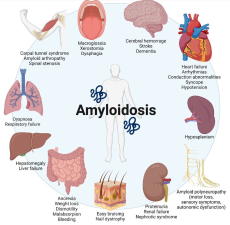Amyloidosis is a clinical syndrome in which amyloid substances are deposited in various organs in the body due to various reasons, causing the function of the affected organs to gradually fail. Amyloid substances are protein-like substances. The cause of amyloid deposition is still unclear, and may be related to environmental factors, immune factors, infectious factors, etc. It includes a group of diseases that can affect different organs or tissues such as the kidneys, heart, and liver, and gradually lead to their dysfunction or even functional failure. At present, colchicine and other general supportive treatments can be used clinically to relieve patient symptoms and delay the progression of lesions. Amyloidosis is mainly symptomatic and cannot be cured radically.

- Systemic ones are:
- Those limited to a certain organ include:
- Organ dysfunction: Amyloid substances deposit in organs, which will interfere with the normal structure and function of organs. For example, in the kidneys, it affects the filtration function of the glomeruli; in the heart, it affects the contraction and relaxation function of the myocardium; in the liver, it affects the metabolism and detoxification function of the liver, etc., which eventually leads to dysfunction of the entire organ function.
- Nephrotic syndrome: Amyloid substances are deposited in the glomeruli, destroying the filtration barrier of the glomeruli. A large amount of protein is lost from the urine, resulting in proteinuria, accompanied by typical manifestations of nephrotic syndrome such as hypoproteinemia, edema and hyperlipidemia.
- Cardiomyopathy: Amyloid substances deposit between myocardial cells, disrupting the normal arrangement of myocardial cells and reducing the compliance of the myocardium. The contraction and relaxation functions of the heart are affected, and symptoms such as heart failure and arrhythmia may occur, seriously affecting heart function.
- Peripheral neuropathy: Amyloid substances invade peripheral nerves and affect the conduction function of nerves. Patients may experience sensory abnormalities, such as limb numbness, pain, and decreased sensation, and may also affect motor function, leading to symptoms such as muscle weakness.
- Hepatosplenomegaly: Amyloid substances deposit in the liver and spleen, increasing the extracellular matrix of the liver and spleen and affecting cell function. The increase in the volume of the liver and spleen may affect their normal hematopoiesis, immunity, metabolism and other functions.
- Kidneys: proteinuria, hematuria or nephrotic syndrome.
- Heart: myocardial hypertrophy, heart enlargement, conduction block, arrhythmia and refractory heart failure,
- Tongue hypertrophy: speech difficulties and tongue pain.
- Spleen: splenomegaly, but mostly without any symptoms.
- Gastrointestinal tract: abnormal gastrointestinal motility, low gastric tension, malabsorption, pseudo-intestinal obstruction and bleeding,
- Skin: papules, nodules, purpura, etc.
- Skeletal muscle: pseudo-skeletal muscle hypertrophy.
- Pay attention to not drinking alcohol and eating spicy and other irritating foods in daily life.
- Pay attention to not using hot water to wash the affected area in daily life. Even if the skin lesions are completely subsided and itchy, it is not suitable to wash it with hot water.
- Friends should also pay attention to avoid scratching or rubbing as much as possible in daily life to avoid aggravating the condition.
- It should also be noted that for primary cutaneous amyloidosis, it is not recommended to use hormones for internal or external treatment, nor is it suitable to use freezing and heat therapy, including laser, ion and other treatment methods.














